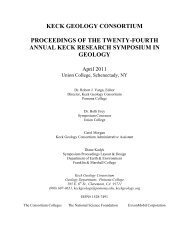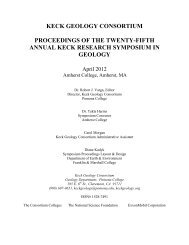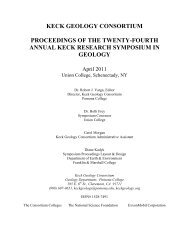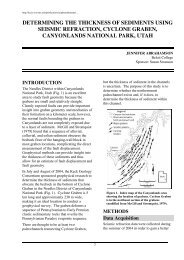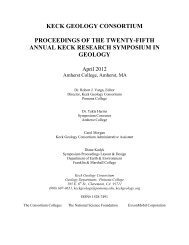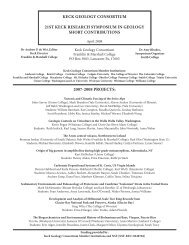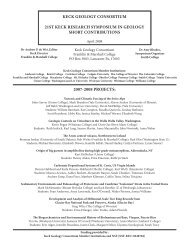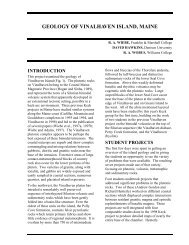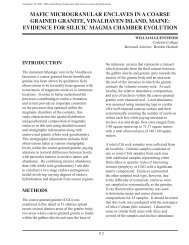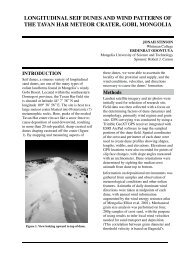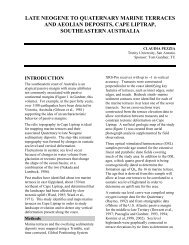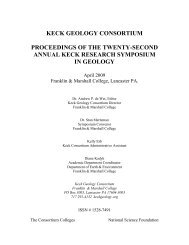Metamorphic evolution of high-pressure, low-temperature mafic ...
Metamorphic evolution of high-pressure, low-temperature mafic ...
Metamorphic evolution of high-pressure, low-temperature mafic ...
You also want an ePaper? Increase the reach of your titles
YUMPU automatically turns print PDFs into web optimized ePapers that Google loves.
<strong>Metamorphic</strong> <strong>evolution</strong> <strong>of</strong> <strong>high</strong>-<strong>pressure</strong>, <strong>low</strong>-<strong>temperature</strong> <strong>mafic</strong> rocks near<br />
Kini on the island <strong>of</strong> Syros, Greece<br />
Erica DiFilippo<br />
Department <strong>of</strong> Geology, Smith College, Clark Science Center, Northampton, MA 01063-0100<br />
Faculty sponsor: John B. Brady, Smith College<br />
INTRODUCTION<br />
The island <strong>of</strong> Syros in the Greek Cyclades exposes Eocene <strong>high</strong>-<strong>pressure</strong>, <strong>low</strong> <strong>temperature</strong> metamorphic<br />
rocks including marbles, blueschists and pelitic schists (Ridley, 1981). It has been proposed that these units have<br />
experienced two major eclogite-blueschist facies metamorphic events, the first occurring at 470-520°C and 14-18 kb<br />
and the second not exceeding 460°C and 14 kb (Lister, 1996). At approximately 20-25 Ma, these units became<br />
regionally overprinted by a medium-<strong>pressure</strong> metamorphism (Schliestedt, 1987).<br />
A well exposed sequence <strong>of</strong> metamorphosed <strong>mafic</strong> and ultra-<strong>mafic</strong> rocks outcrops along a 2.5 km long<br />
coastal cliff near Kini on the western coast <strong>of</strong> Syros. This suite consists <strong>of</strong> segments <strong>of</strong> glaucophane schist, eclogite,<br />
omphacite-epidote rock, pelitic schist, and serpentinite with blackwall reaction zones separating the serpentinite<br />
from the other rock types. This study combines petrographic and chemical evidence in order to determine whether<br />
the difference in the units exposed at Kini is due to differing bulk compositions or to differing metamorphic grades.<br />
FIELD RELATIONS<br />
Lithologies change dramatically over the 2.5 km coastal cliff <strong>of</strong> Kini. There is no distinct gradational<br />
pattern to the rock units exposed. Beginning at the southern tip <strong>of</strong> the field area and working northward, the rock<br />
units are glaucophane schist, omphacite-zoisite rock, glaucophane schist, eclogite, serpentinite and blackwall<br />
reaction zones, glaucophane schist, a greenschist facies unit and pelitic schist. The units are separated by marbles,<br />
which were not studied. These marbles are in fault contact with the <strong>mafic</strong> and ultra-<strong>mafic</strong> rocks at Kini. These are<br />
steep, non-layer-parallel faults. The serpentinite and blackwall reaction zones are the only units at Kini that are in<br />
direct, non-faulted contact with another unit. The serpentinite and blackwall reaction zones serve as a matrix for a<br />
jumble <strong>of</strong> rounded blocks <strong>of</strong> eclogite and omphacite-zoisite rocks. The Galissas Fault Zone separates the entire<br />
sequence <strong>of</strong> <strong>mafic</strong> and ultra-<strong>mafic</strong> units from the main marble and pelitic schist units <strong>of</strong> central Syros (Dixon and<br />
Ridley, 1987).<br />
PETROGRAPHY<br />
Glaucophane Schist In the field, glaucophane schist is identified by its blue color and distinct foliation.<br />
In general, these units are composed <strong>of</strong> 40% glaucophane, 5-20% garnet, 10-15% epidote, 10-15% chlorite, 10%<br />
rutile, 5-10% phengite, 5% titanite, 5% apatite and 5% albite. Although not apparent in all grains, 20% <strong>of</strong> the<br />
glaucophane crystals display color variations in the individual grains, indicating chemical zonation (Figure 1). In<br />
the field, the glaucophane schist outcrops are compositionally banded. These bands are on average 15-30 cm thick<br />
and are defined by an abundance <strong>of</strong> either glaucophane, garnet, phengite or chlorite. Glaucophane and phengite<br />
define the foliation <strong>of</strong> the glaucophane schist.<br />
Ecolgite The eclogite units at Kini are not as abundant as the glaucophane schists. The eclogite at Kini is<br />
identified by its dark, almost black, color, 1/2-1 cm grain size and absence <strong>of</strong> a distinct foliation. These units are<br />
composed <strong>of</strong> 20-25% glaucophane, 15-20% epidote, 5-20% garnet, 10-20% chlorite, 5-10% apatite, 10% titanite,<br />
10% albite, 5% rutile, 5% omphacite and
individual grains, indicating chemical zoning. Rutile appears in concentrated clusters through the eclogite samples.<br />
These clusters are consistently surrounded by titanite. Garnets in two eclogite samples have a halo <strong>of</strong> phengite.<br />
Omphacite-Epidote Unit Along the coast <strong>of</strong> Kini, the omphacite-epidote units are very distinctive white<br />
units with large (1-3 cm) green minerals. The unit is composed <strong>of</strong> 50% clinozoisite/epidote, 20% chlorite, 15%<br />
omphacite, 10% rutile,
ulk chemistry rather than differences due to metamorphism. This conclusion corresponds with the conclusion<br />
reached by Schliestedt (1986) for similar rocks on the nearby island <strong>of</strong> Sifnos.<br />
REFERENCES CITED<br />
Dixon, J.E. and Ridley, J. 1987. Syros (Field Trip Excursion). In: Chemical Transport in Metasomatic Processes.<br />
Nato Advanced Study Institutes Series. Series C. pg. 489-500.<br />
Lister, Gordon S. and Raouzaious, Adamandia. 1996. The Tectonic Significance <strong>of</strong> a Porphyroblastic Blueschist<br />
Facies Overprint During Alpine Orogenesis: Sifnos, Aegean Sea, Greece. Journal <strong>of</strong> Structural Geology.<br />
Vol 18. No 12. Pg 1417-1435.<br />
Ridley J. 1981. Arcuate Lineation Trends in a Deep Level, Ductile Thrust Belt, Syros, Greece. Tectonophysics.<br />
Vol 88 (3-4). Pg 347-360.<br />
Schliestedt, M. 1987. Transformation <strong>of</strong> Blueschist to Greenschist Facies Rocks as a Consequence <strong>of</strong> Fluid<br />
Infiltration. Contributions to Mineralogy and Petrology. Vol 97. Pg 237-250.<br />
Schliestedt, M. 1986. Eclogite-Blueschist Relationships as Evidenced by Mineral Equilibria in the High-Pressure<br />
rocks <strong>of</strong> Sifnos (Cycladic Islands). Greece. J. Petrol. 27. 1437-1459.<br />
Figure 1. Photomicrograph displaying chemical<br />
zonation distinguished by color variations in<br />
0.5mm long grain <strong>of</strong> glaucophane.<br />
Figure 2. Backscattered electron image <strong>of</strong> zoned<br />
glaucophane.<br />
Figure 3. Backscattered electron image <strong>of</strong> grain<br />
thought to be lawsonite in the field. Field <strong>of</strong> view<br />
is 0.5mm.
Projection from:<br />
Zoisite<br />
Quartz<br />
H2O<br />
N`<br />
N`=2Na2O<br />
Mineral Composition<br />
Projection from:<br />
Zoisite<br />
Quartz<br />
H2O<br />
N`<br />
N`=2Na2O<br />
Mineral Composition<br />
Omph<br />
Gl<br />
Gar - Garnet<br />
Gl - Glaucophane<br />
Omph - Omphacite<br />
Gl<br />
Gar - Garnet<br />
Gl - Glaucophane<br />
Omph - Omphacite<br />
CM`<br />
A`<br />
Gar<br />
CM`=(Fe, Mg)O<br />
A`= Al2O3+0.75(Fe, Mg)O<br />
Figure 4.<br />
-Na2O-0.75Cao<br />
Ternary Phase Diagram <strong>of</strong> Eclogite.<br />
CM`<br />
A`<br />
Gar<br />
CM`=(Fe, Mg)O<br />
A`= Al2O3+0.75(Fe, Mg)O<br />
-Na2O-0.75Cao<br />
Figure 5.<br />
Ternary Phase Diagram <strong>of</strong> Glaucophane Schist.<br />
Circled Area Indictaes Greenschist Facies Amphiboles.<br />
Projection from:<br />
Zoisite<br />
Quartz<br />
H2O<br />
N`<br />
N`=2Na2O<br />
Whole Rock Chemistry<br />
Projection from:<br />
Zoisite<br />
Quartz<br />
H2O<br />
N`<br />
N`=2Na2O<br />
Whole Rock Chemistry<br />
CM`<br />
CM`=(Fe, Mg)O<br />
A`<br />
A`= Al2O3+0.75(Fe, Mg)O<br />
-Na2O-0.75Cao<br />
Figure 6.<br />
Ternary Diagram <strong>of</strong> Whole Rock Chemistry <strong>of</strong> Eclogite.<br />
(Triangle from Figure 4 plotted.)<br />
CM`<br />
A`<br />
CM`=(Fe, Mg)O<br />
A`= Al2O3+0.75(Fe, Mg)O<br />
-Na2O-0.75Cao<br />
Figure 7.<br />
Ternary Diagram <strong>of</strong> Whole Rock Chemistry <strong>of</strong><br />
Glaucophane Schist.<br />
(Tie line from Figure 5 plotted.)



